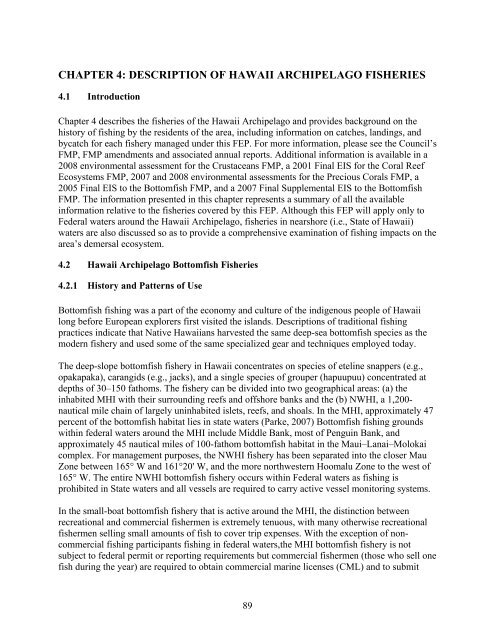Hawaii FEP - Western Pacific Fishery Council
Hawaii FEP - Western Pacific Fishery Council
Hawaii FEP - Western Pacific Fishery Council
You also want an ePaper? Increase the reach of your titles
YUMPU automatically turns print PDFs into web optimized ePapers that Google loves.
CHAPTER 4: DESCRIPTION OF HAWAII ARCHIPELAGO FISHERIES4.1 IntroductionChapter 4 describes the fisheries of the <strong>Hawaii</strong> Archipelago and provides background on thehistory of fishing by the residents of the area, including information on catches, landings, andbycatch for each fishery managed under this <strong>FEP</strong>. For more information, please see the <strong>Council</strong>’sFMP, FMP amendments and associated annual reports. Additional information is available in a2008 environmental assessment for the Crustaceans FMP, a 2001 Final EIS for the Coral ReefEcosystems FMP, 2007 and 2008 environmental assessments for the Precious Corals FMP, a2005 Final EIS to the Bottomfish FMP, and a 2007 Final Supplemental EIS to the BottomfishFMP. The information presented in this chapter represents a summary of all the availableinformation relative to the fisheries covered by this <strong>FEP</strong>. Although this <strong>FEP</strong> will apply only toFederal waters around the <strong>Hawaii</strong> Archipelago, fisheries in nearshore (i.e., State of <strong>Hawaii</strong>)waters are also discussed so as to provide a comprehensive examination of fishing impacts on thearea’s demersal ecosystem.4.2 <strong>Hawaii</strong> Archipelago Bottomfish Fisheries4.2.1 History and Patterns of UseBottomfish fishing was a part of the economy and culture of the indigenous people of <strong>Hawaii</strong>long before European explorers first visited the islands. Descriptions of traditional fishingpractices indicate that Native <strong>Hawaii</strong>ans harvested the same deep-sea bottomfish species as themodern fishery and used some of the same specialized gear and techniques employed today.The deep-slope bottomfish fishery in <strong>Hawaii</strong> concentrates on species of eteline snappers (e.g.,opakapaka), carangids (e.g., jacks), and a single species of grouper (hapuupuu) concentrated atdepths of 30–150 fathoms. The fishery can be divided into two geographical areas: (a) theinhabited MHI with their surrounding reefs and offshore banks and the (b) NWHI, a 1,200-nautical mile chain of largely uninhabited islets, reefs, and shoals. In the MHI, approximately 47percent of the bottomfish habitat lies in state waters (Parke, 2007) Bottomfish fishing groundswithin federal waters around the MHI include Middle Bank, most of Penguin Bank, andapproximately 45 nautical miles of 100-fathom bottomfish habitat in the Maui–Lanai–Molokaicomplex. For management purposes, the NWHI fishery has been separated into the closer MauZone between 165° W and 161°20' W, and the more northwestern Hoomalu Zone to the west of165° W. The entire NWHI bottomfish fishery occurs within Federal waters as fishing isprohibited in State waters and all vessels are required to carry active vessel monitoring systems.In the small-boat bottomfish fishery that is active around the MHI, the distinction betweenrecreational and commercial fishermen is extremely tenuous, with many otherwise recreationalfishermen selling small amounts of fish to cover trip expenses. With the exception of noncommercialfishing participants fishing in federal waters,the MHI bottomfish fishery is notsubject to federal permit or reporting requirements but commercial fishermen (those who sell onefish during the year) are required to obtain commercial marine licenses (CML) and to submit89












